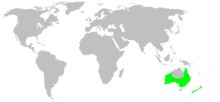| Sheetweb spiders | |
|---|---|

| |
| Stiphidion facetum | |
| Scientific classification | |
| Domain: | Eukaryota |
| Kingdom: | Animalia |
| Phylum: | Arthropoda |
| Subphylum: | Chelicerata |
| Class: | Arachnida |
| Order: | Araneae |
| Infraorder: | Araneomorphae |
| Family: | Stiphidiidae Dalmas, 1917 |
| Diversity | |
| 20 genera, 126 species | |

| |
Stiphidiidae, also called sheetweb spiders, is a family of araneomorph spiders first described in 1917.[1] Most species are medium size (Stiphidion facetum is about 8 millimetres (0.31 in) long) and speckled brown with long legs. All members of this family occur in New Zealand and Australia except for Asmea.[2] They build a horizontal sheet-like web under rocks, hence the name "sheetweb spiders".
The largest of New Zealand's species is Cambridgea foliata, with a body length up to 2.5 centimetres (0.98 in) and a span of up to 15 centimetres (5.9 in). Hikers and trampers often find their sheet-like webs that can be up to 1 metre (3 ft 3 in) across, but the spider itself is nocturnal, spending the day time inside its web tunnel.[3] It can also be found in gardens and males may enter human homes. Their large size, including mouth parts up to 1 centimetre (0.39 in) long, may be intimidating, but it is considered harmless to humans and bites are extremely rare.
- ^ Dalmas, R. de (1917). "Araignées de Nouvelle-Zélande". Annales de la Société Entomologique de France. 86: 317–430.
- ^ Cite error: The named reference
NMBEwas invoked but never defined (see the help page). - ^ "SHEETWEB SPIDER". Manaaki Whenua Landcare Research. Retrieved 2019-04-24.